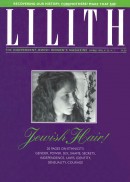
“As an Adopted Child, All I Wanted was Real Jewish Hair”
Randy Millen, an adopted daughter, struggles with hair that "couldn’t possibly be Jewish." Hair and difference.
Dr. Randy Millen, currently Dean of the College at Haverford College, was adopted as an infant in 1951. During those years in Massachusetts, adoptive parents were required by law to be of the same faith as the child’s birth mother. Growing up as a Jew in the working-class mill town of Haverhill, Massachusetts, Millen’s blond hair became the stage upon which she rehearsed and acknowledged her torment about her “real” identity.
I always knew intellectually that I was adopted, and that my biological mother was Jewish, but then there was this HAIR—”dirty blond.” it was called then, baby-fine, thin, wispy hair. To myself I called it “shiksa hair.'” I didn’t know who my biological father was.
The Jewish community in Haverhill, Massachusetts, was a major factor in my life. It was tightly knit, 300 families. From early on, I longed to “look Jewish,” which to me meant getting rid of “the hair,” meant having real, dark curly Jewish hair.
One of my earliest memories is being shlepped to Helen’s Beauty Parlor for “body permanents”—it was either 5 perms before the age of 4, or 4 before the age of 5. I would sit there, this tiny girl with terrible hair, all the ladies and smells and rollers, capes, such scenes. And then I would leave Helen’s with these Shirley Temple curls—but by the time we got home, my hair would be all straight and horrible again. It was sad. It was tragic. My mother really wanted a little girl with curls—so this was her tragedy as well as mine. I was an only child.
By the time I hit adolescence—with bar mitzvah parties constantly—I would go to synagogue each week with dirty hair (but with a hat on), and then walk down to Helen’s Beauty Parlor and get my hair washed and set. It felt like a lonely journey from shul to Helen’s.
By the time my mother picked me up, it seemed like hours. I would cry and scream about how my hair was “wrong”—and it was somehow my mother’s fault. Red-eyed, I’d get picked up to go to the bar mitzvah party.
I never thought of any larger “blond American ideal,” but just Haverhill with its Irish Catholics (also dark-haired) and Jews. All I wanted was to “look Jewish,” to belong. All my cousins had much better hair. I knocked myself out trying to be Jewish—I even won the Rabbi Abraham Isaac Jacobson Leadership award in confirmation class. I had friends who ironed their curly thick frizzy hair so that they’d look like WASP icons—that was so perplexing.
I first met my biological mother when I was in my mid-20s. I walked in the door and asked to use her bathroom, and there were all these products for baby-fine, thin hair, terrible hair. What an irony—the “shiksa hair” was Jewish! I came out of the bathroom and announced to her: “Everything else is negotiable, but I’ll never forgive you for the hair.”
She laughed.
All those times that people had said to me, “Gee, you don’t look Jewish.” If only once someone had said the opposite—that would have been the best day of my life.

